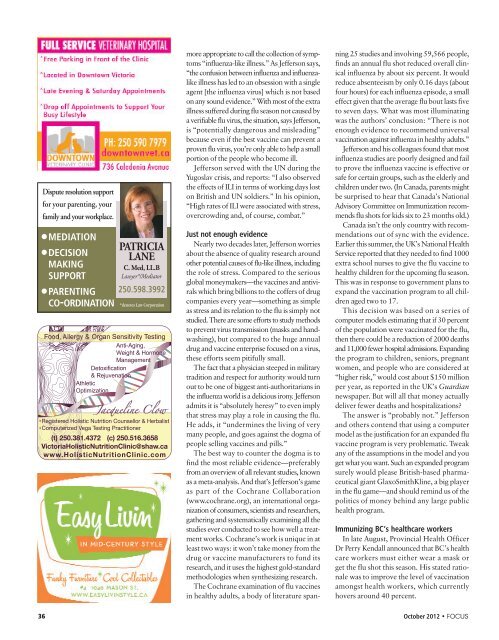**October 2012 Focus - Focus Magazine
**October 2012 Focus - Focus Magazine
**October 2012 Focus - Focus Magazine
You also want an ePaper? Increase the reach of your titles
YUMPU automatically turns print PDFs into web optimized ePapers that Google loves.
Dispute resolution support<br />
for your parenting, your<br />
family and your workplace.<br />
•<br />
•<br />
•<br />
MEDIATION<br />
DECISION<br />
MAKING<br />
SUPPORT<br />
PARENTING<br />
CO-ORDINATION<br />
PATRICIA<br />
LANE<br />
C. Med, LL.B<br />
Lawyer*/Mediator<br />
250.598.3992<br />
*denotes Law Corporation<br />
more appropriate to call the collection of symptoms<br />
“influenza-like illness.” As Jefferson says,<br />
“the confusion between influenza and influenzalike<br />
illness has led to an obsession with a single<br />
agent [the influenza virus] which is not based<br />
on any sound evidence.” With most of the extra<br />
illness suffered during flu season not caused by<br />
a verifiable flu virus, the situation, says Jefferson,<br />
is “potentially dangerous and misleading”<br />
because even if the best vaccine can prevent a<br />
proven flu virus, you’re only able to help a small<br />
portion of the people who become ill.<br />
Jefferson served with the UN during the<br />
Yugoslav crisis, and reports: “I also observed<br />
the effects of ILI in terms of working days lost<br />
on British and UN soldiers.” In his opinion,<br />
“High rates of ILI were associated with stress,<br />
overcrowding and, of course, combat.”<br />
Just not enough evidence<br />
Nearly two decades later, Jefferson worries<br />
about the absence of quality research around<br />
other potential causes of flu-like illness, including<br />
the role of stress. Compared to the serious<br />
global moneymakers—the vaccines and antivirals<br />
which bring billions to the coffers of drug<br />
companies every year—something as simple<br />
as stress and its relation to the flu is simply not<br />
studied. There are some efforts to study methods<br />
to prevent virus transmission (masks and handwashing),<br />
but compared to the huge annual<br />
drug and vaccine enterprise focused on a virus,<br />
these efforts seem pitifully small.<br />
The fact that a physician steeped in military<br />
tradition and respect for authority would turn<br />
out to be one of biggest anti-authoritarians in<br />
the influenza world is a delicious irony. Jefferson<br />
admits it is “absolutely heresy” to even imply<br />
that stress may play a role in causing the flu.<br />
He adds, it “undermines the living of very<br />
many people, and goes against the dogma of<br />
people selling vaccines and pills.”<br />
The best way to counter the dogma is to<br />
find the most reliable evidence—preferably<br />
from an overview of all relevant studies, known<br />
as a meta-analysis. And that’s Jefferson’s game<br />
as part of the Cochrane Collaboration<br />
(www.cochrane.org), an international organization<br />
of consumers, scientists and researchers,<br />
gathering and systematically examining all the<br />
studies ever conducted to see how well a treatment<br />
works. Cochrane’s work is unique in at<br />
least two ways: it won’t take money from the<br />
drug or vaccine manufacturers to fund its<br />
research, and it uses the highest gold-standard<br />
methodologies when synthesizing research.<br />
The Cochrane examination of flu vaccines<br />
in healthy adults, a body of literature span-<br />
ning 25 studies and involving 59,566 people,<br />
finds an annual flu shot reduced overall clinical<br />
influenza by about six percent. It would<br />
reduce absenteeism by only 0.16 days (about<br />
four hours) for each influenza episode, a small<br />
effect given that the average flu bout lasts five<br />
to seven days. What was most illuminating<br />
was the authors’ conclusion: “There is not<br />
enough evidence to recommend universal<br />
vaccination against influenza in healthy adults.”<br />
Jefferson and his colleagues found that most<br />
influenza studies are poorly designed and fail<br />
to prove the influenza vaccine is effective or<br />
safe for certain groups, such as the elderly and<br />
children under two. (In Canada, parents might<br />
be surprised to hear that Canada’s National<br />
Advisory Committee on Immunization recommends<br />
flu shots for kids six to 23 months old.)<br />
Canada isn’t the only country with recommendations<br />
out of sync with the evidence.<br />
Earlier this summer, the UK’s National Health<br />
Service reported that they needed to find 1000<br />
extra school nurses to give the flu vaccine to<br />
healthy children for the upcoming flu season.<br />
This was in response to government plans to<br />
expand the vaccination program to all children<br />
aged two to 17.<br />
This decision was based on a series of<br />
computer models estimating that if 30 percent<br />
of the population were vaccinated for the flu,<br />
then there could be a reduction of 2000 deaths<br />
and 11,000 fewer hospital admissions. Expanding<br />
the program to children, seniors, pregnant<br />
women, and people who are considered at<br />
“higher risk,” would cost about $150 million<br />
per year, as reported in the UK’s Guardian<br />
newspaper. But will all that money actually<br />
deliver fewer deaths and hospitalizations?<br />
The answer is “probably not.” Jefferson<br />
and others contend that using a computer<br />
model as the justification for an expanded flu<br />
vaccine program is very problematic. Tweak<br />
any of the assumptions in the model and you<br />
get what you want. Such an expanded program<br />
surely would please British-based pharmaceutical<br />
giant GlaxoSmithKline, a big player<br />
in the flu game—and should remind us of the<br />
politics of money behind any large public<br />
health program.<br />
Immunizing BC’s healthcare workers<br />
In late August, Provincial Health Officer<br />
Dr Perry Kendall announced that BC’s health<br />
care workers must either wear a mask or<br />
get the flu shot this season. His stated rationale<br />
was to improve the level of vaccination<br />
amongst health workers, which currently<br />
hovers around 40 percent.<br />
36 October <strong>2012</strong> • FOCUS
















